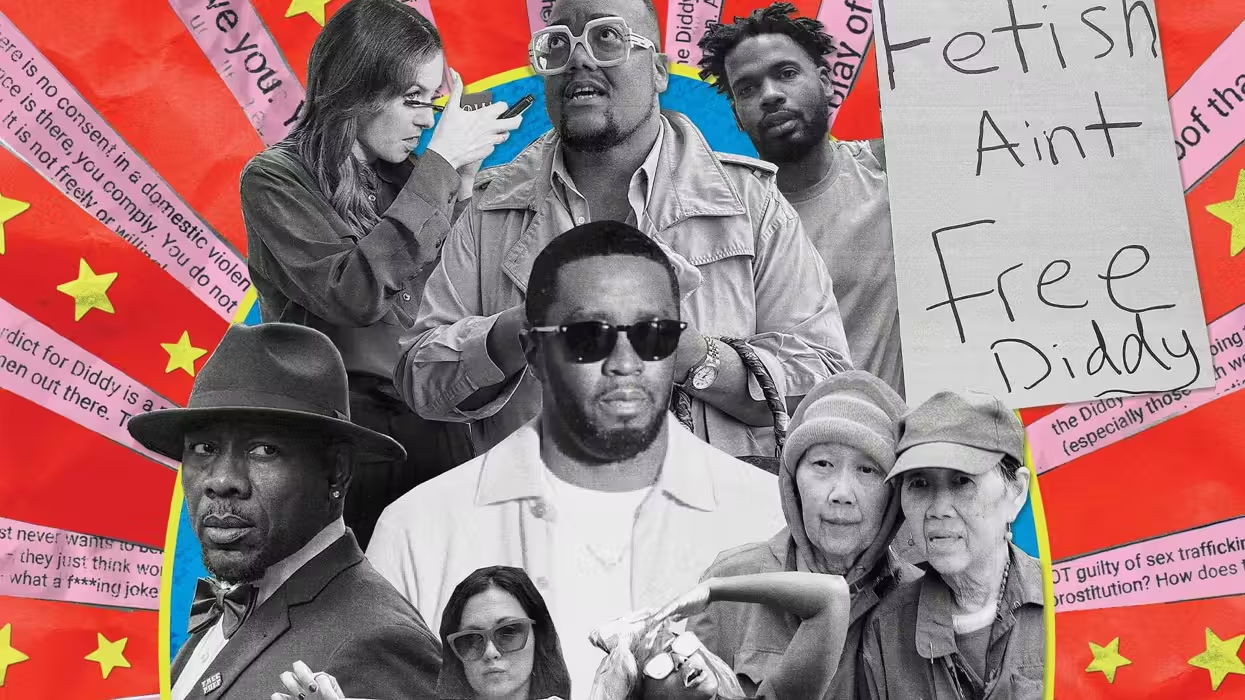
Sian Roper

The most absurd trial of the decade showcased how the internet has invaded reality.
For two months, the sidewalks outside the Sean Combs trial were alive with pilgrims, hustlers, and YouTubers—an improvised carnival of voices competing to narrate the fall of a mogul.
Harlem is always lit on the Fourth of July. I was sipping a mango margarita on Malcolm X Boulevard while bubblegum-pink smoke bombs fogged the street. Roman candles burst into the night, illegal fireworks cracked from every direction. Most people were celebrating America’s Independence Day, but my group was toasting to the official end of the United States v. Sean Combs trial—in the neighborhood where P. Diddy, a.k.a. Puff Daddy, a.k.a. Puff, was born Sean Combs, a name to which he’d someday have to answer in federal court.
Harlem has always been branded as the heart of Bad Boy Records, even though the label’s headquarters were downtown in Manhattan. Still, on a night like this, Harlem felt like Bad Boy’s backyard—even though Combs himself sat across town, locked up in his Brooklyn cell after U.S. District Judge Arun Subramanian denied his motion for bail.
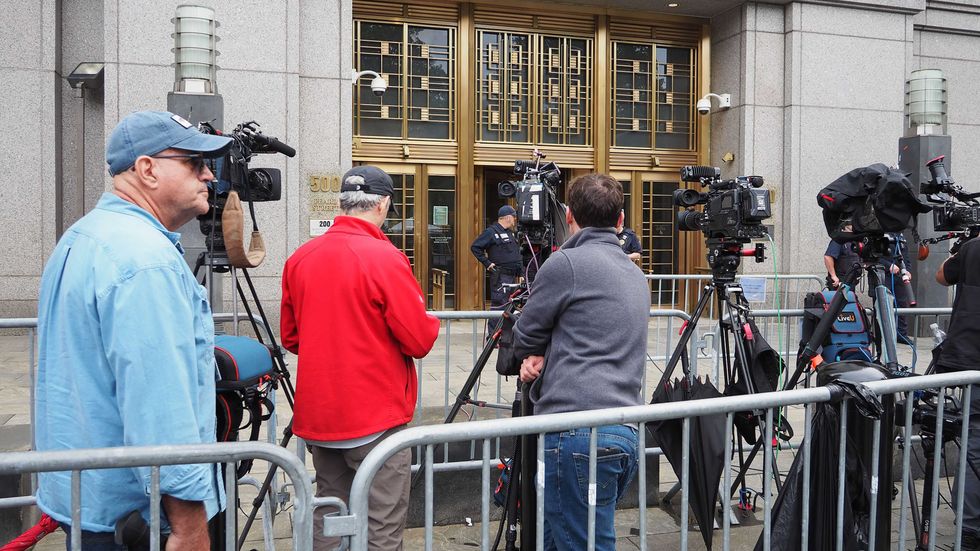
I went live on Instagram one last time before flying home to Los Angeles, streaming the final act of what’s become a two-month circus. Around me is my new, dysfunctional, East Coast family—the characters my audience have come to know as well as Diddy. Independent reporters. Sketch artists. Harlem locals in “Free Diddy” shirts. An infamous line-sitter known as the Hollywood Creeper. And the Haitian man who says I’m his favorite white person after Justin Bieber.
Music producer Charlucci Finney—Diddy’s so-called “Godbrother”—paced the patio in his signature “Free Puff” hat, the same one paparazzi caught him wearing every day while escorting the Combs family in and out of the courthouse. That night, he was the host, inviting everyone to his neighborhood lounge for one last post-trial hoorah.
Diddy himself whipped his head around in shock. Mouth open, stunned, as if even he couldn't believe the circus had breached containment and rushed inside.
While locals at the bar were toasting to America’s independence, Charlucci was drinking to his close friend just having dodged the heaviest charges—racketeering and sex trafficking—and the fact that he wouldn’t have to explain what “God-brother” means to reporters anymore. The journalists on the patio were celebrating something else entirely: a two-month run of independently-funded coverage that held its own against the legacy press.
It feels like the last night of summer camp. It’s hard to say goodbye knowing you’ll likely never see these people again.
Finally, after living inside the hive mind of the circus for so long, a bolt of self-awareness kicks in.
How the hell did I end up here?
It’s the night before the highly anticipated United States v. Sean Combs trial. The 55-year-old Bad Boy Records founder is just hours away from putting on the most important show of his life. For the next two months, he’ll sit quietly before a jury that will decide whether he is guilty of charges including racketeering conspiracy, sex trafficking, and transportation for purposes of prostitution.
It is 5:00 p.m., and somehow, the street is already filling up with people sprawling out on the curb.
“It’s fucking dystopia that we’re sleeping outside to get inside a courthouse,” a woman with brown curly hair shouts at me on the sidewalk. She’s wearing a brown sundress and has oversized sunglasses, fogged with tears.
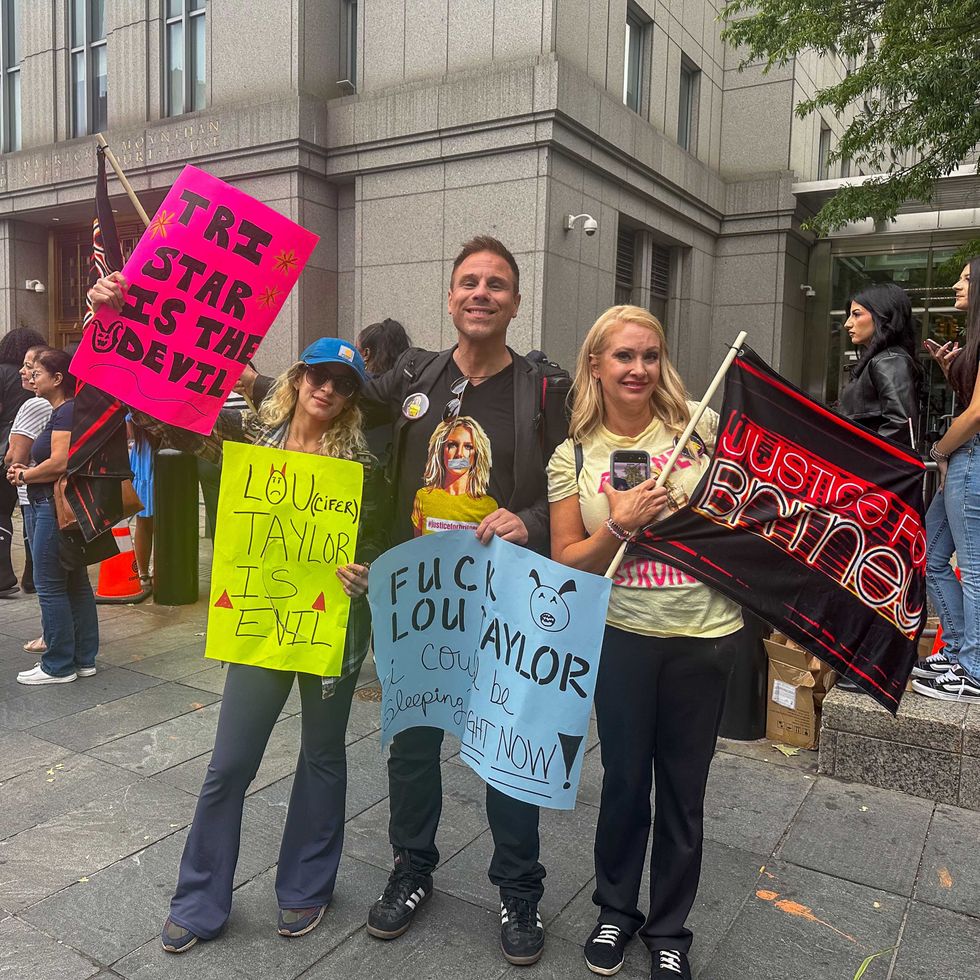
She taped a piece of yellow paper on the ground that read: “This Spot is Reserved for Independent Media who Can’t Compete with Billionaire-Backed Budgets.” An older woman parked in a lawn chair shoots her a dirty look. Another girl, in French braids, crawls out of a tent shaped like a portable spray-tan booth and introduces herself as the “line manager.”
She politely asks the crying woman to calm down, worried she is “disturbing the peace of her staff” of professional line-sitters—people literally paid to camp on the sidewalk overnight so others can buy their way into the federal courtroom.
Unlike the trials of O. J. Simpson, Michael Jackson, and Johnny Depp, this one wouldn’t be televised. With only a handful of seats available each day, media outlets and a few YouTubers were shelling out up to $500 a day for a line-sitter just to secure a coveted spot in the main courtroom.
A hippie-looking guy with a scraggly beard wanders up to me, grinning. He is warm and funny—a sharp contrast to the uptight line-sitters already zipping up their tents at 8:00 p.m. like it’s lights-out at summer camp. He tells me not to waste my money on the official “LINEDUDES.” He’ll hold my spot for half the price.
Apparently, line-sitters come in two breeds—the “professionals” and the “unprofessionals.” The “professionals” sleep in hats with neon green lettering, and the “unprofessionals” are New Yorkers who want extra cash. Both still have to sleep on the sidewalk.
It’s my first time covering a trial, so I ask the hysterical woman if this is common.
“During Ghislaine Maxwell, there were maybe one or two line-sitters if people were exhausted—but it wasn’t people camping out from 5:00 p.m. the day before,” she explains, with enough composure to answer in detail. Upset that TMZ, Rolling Stone, and New York Times reporters were at home in bed, she laments that independent media like her either have to fundraise to pay these crazy rates or sleep outside with them, sacrificing both shuteye and sanity.
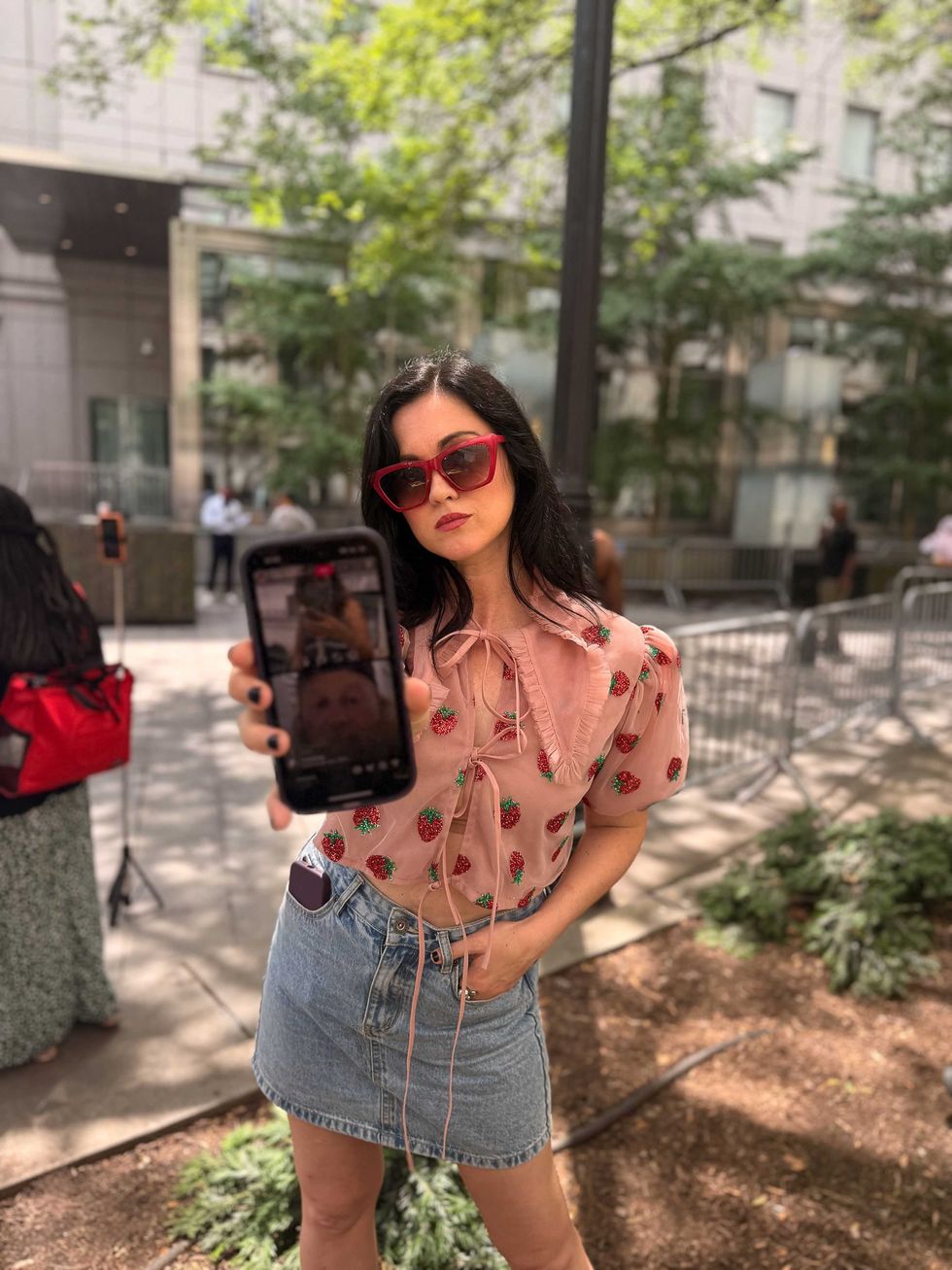
I kick off my coverage, going live on Instagram. My audience, immediately invested in the characters and chaos hanging out on the curb, advise me to sleep outside.
A chubby guy in a pink polo waddles into frame and asks what all the commotion’s about. When he realizes he’s on the livestream, he introduces himself as a former correctional officer who now hosts “wonton tours” in Chinatown.
The sun sets and a fight immediately breaks out between the line-sitters. A man in a pinstripe suit taps me on the shoulder and tells me to be careful around one of the fellas I’ve been chatting with. The guy turns into a werewolf at night, he cautions, and sometimes stabs people with a sword. Time for bed!
I arrive at the courthouse the next morning at 4:30 a.m., and the line is already down the block. The Rotten Mango podcast girlies have locked down the first couple of spots. Behind them, stressed-out TMZ staffers scribble into manila notepads. YouTubers in Burberry trench coats and five-inch pumps emerge from Uber Blacks, scanning the crowd for the line-sitter who’s held their place all night.
Paparazzi with long lenses swarm the courthouse steps, waiting for the Combs family to pull up in a black van. Across the street, a row of tents shelters the mainstream media crews. NBC anchors dab powder on their faces before going live for the morning shows. Foreign correspondents drift through the crowd, interviewing line-sitters, amazed that Americans actually sleep on filthy sidewalks just to catch a glimpse of a celebrity trial. Somehow, I’m tenth in line (thanks to the man in the pinstripe suit who held my spot)—which means I’m likely going to make it into the official courtroom for opening statements.
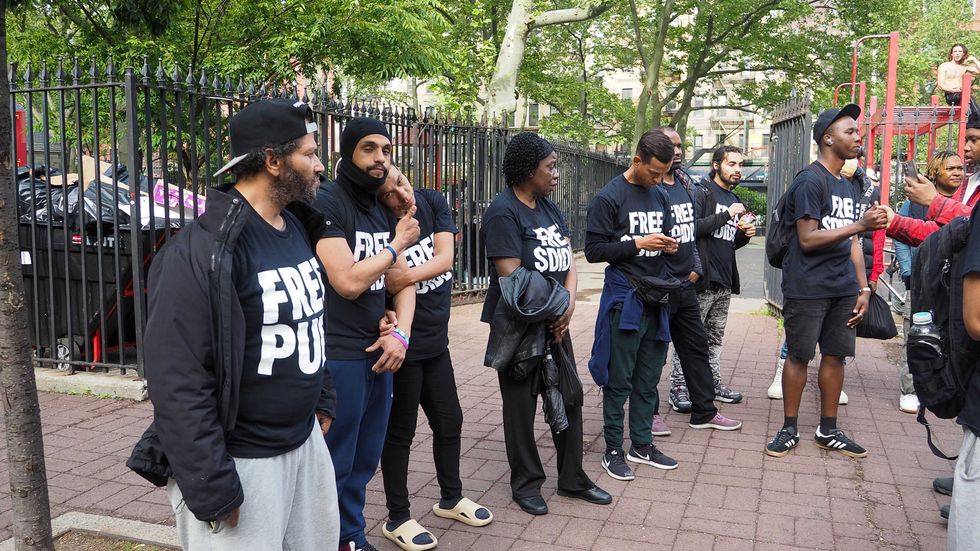
Behind me, a ventriloquist and his puppet argue about Diddy’s fate. The puppet claims that when Diddy walks free, he’s going to stuff him in a suitcase and ship him to Cuba.
“What he did was obviously terrible,” the ventriloquist says, while a German news crew gathers around to capture the bizarre banter.
“What else did you expect from Bad Boy Records? He’s rich, he’s got women around him. What else are you gonna do—read a book to them?” the puppet screams back, becoming the first documented “Free Puff” protester: a balding puppet perched on a battered suitcase.
“Justice for Kim Porter. Support for Cassie,” a familiar female voice whispers.
It’s Jaguar Wright, surrounded by seven-foot bodyguards—the singer-songwriter went viral in the months leading up to the trial by proclaiming that this would be the day the music industry’s demons were finally exposed.
For two months now, content has dominated everything. If you've wanted to stand out, you've had to be louder, weirder, even more unhinged than the next guy.
“We have to remember there are real survivors like Natania Reuben. This is why I’m here,” Wright says now, name-dropping the woman shot in the face by Puffy during a1999 nightclub incident—the infamous night that earned Jennifer Lopez, who held Puff’s gun, the nickname “Jenny with the Glock.”
I upload a clip of her prayer to Instagram. The comment section immediately splits: half call her batshit crazy; half plea that God give her divine protection.
Suddenly, the golden doors swing open. The line starts to move.
Despite all odds—and without paying a single dime or sleeping on the sidewalk—I somehow scored a seat in Room 26B. Thanks, YouTuber who saved me a spot because he was worried a werewolf might stab me...
On the left side of the room, three rows behind Diddy’s immediate family, is the “public” section—a mix of influencers, YouTubers, Substackers, livestreamers, and the occasional homeless New Yorker dozing off after being up all night. The right side, reserved for credentialed press, is stuffed with familiar names: Rolling Stone, NPR, CNN.
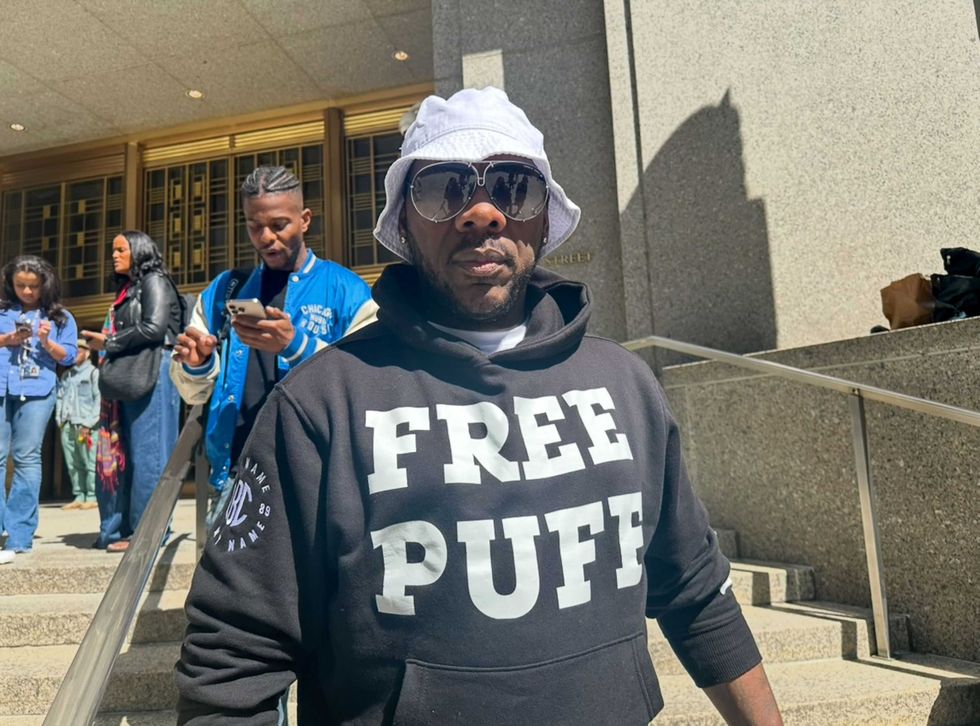
Two floors below is the overflow room, a kind of purgatory for those who didn’t make the cut, watching the trial play out on wall-mounted monitors. (Gene Deal, one of Diddy’s former bodyguards, will be spotted there several times during the trial, often with lottery tickets in his hand.)
“All rise,” Judge Subramanian orders.
Diddy enters the room. His hair is as gray as the cardigan he’s wearing. He spots his family and throws his hands up into the shape of a heart emoji. “Hey Mama,” he says, spotting his mother, and blows her a kiss.
Court is officially in session. A few hours in, I’m already wondering if this trial was meant to desensitize us to alternative sexual lifestyles. It’s not even 3:00 p.m. and we’re already knee-deep in the rap mogul’s bedroom kinks. A male escort describes Diddy’s ritual during a freak-off: standing in the corner of a dim hotel room lit with red bulbs and Diptyque candles, pleasuring himself in the corner with a bandana over his face, watching his (then) girlfriend Cassie Ventura have sex with a (male) escort.
I sprint outside to livestream for my audience, just in time to catch Diddy’s twin sons leaving the courthouse in matching suits and reporters swarming Attorney Gloria Allred.
“He’s a wealthy man, his future is at stake,” Allred tells us, nodding toward Diddy’s alleged $10 million-plus defense team. “Let’s see what they can do.”
Later that night, YouTuber Armon Wiggins brings the testimony to life, reenacting for his 280,000 subscribers the entire freak-off scene, bandana corner and all.
The internet is both disturbed and entertained.
That was day one.
For the next eight weeks, journalists fill the wooden pews, scribbling notes while 34 witnesses—ex-girlfriends, employees, male escorts—take the stand. Kid Cudi testifies that he believes Diddy firebombed his Porsche.
I slip out of the courtroom five minutes early every day to break the story first. More often than not, I go viral—sometimes for throwaways like “Diddy likes applesauce on his cheeseburgers,” other times for luridly detailed bombshells concerning what Diddy liked his girlfriend to do to him.
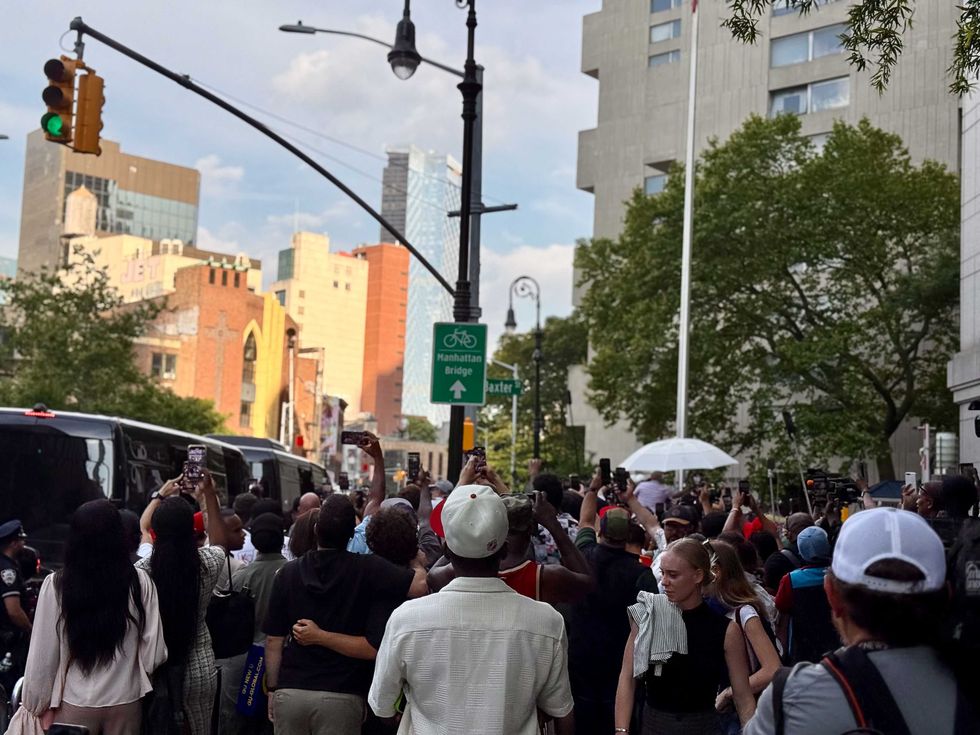
Legacy outlets like The Hollywood Reporter and The Wall Street Journal eventually start writing about all the new faces in the courtroom. But it’s indie journalists and content creators breaking the scoops, racking up millions of views, and shaping the narrative online. The Diddy trial pulls in more livestreamers, YouTubers, and Substackers than any case in history, turning the courthouse into both a newsroom and what the industry would now call an “unstructured” reality show set.
After a few weeks, the freak-off stories get old. The public is sick of hearing about Diddy’s fascination with baby oil.
The internet had expected the bombshells—and hoped for secrets so explosive they’d blow the all-seeing eye off the Illuminati pyramid for good. They expected turbocharged testimonies to match the conspiracy theories that kept them doom-scrolling for months: alleged VMA gangbangs, celebrity blackmail tapes starring Ashton Kutcher and Oprah, murder plots tied to Tupac and Biggie. TikTokers primed them to expect Satanic ritual revelations and even a necrophilia story inspired by a baseless claim that went viral after an influencer confused the words “necrophilia” and “necromancy.”
The internet was primed for the Diddy trial to be the Pizzagate of the music industry—not a Johnson&Johnson commercial. But week after week, the celebrity cameos everyone prayed for never materialized. Justin Bieber and Usher never took the stand. Jennifer Lopez stayed silent. Clive Davis wasn’t mentioned once. The hype for the trial began to deflate.
Now that the trial is halfway through, the internet has begun to care more about the freak show outside the courthouse than the freak-off stories inside...
I watch Big Mike, a native New Yorker, light a giant cigar and ask Diddy’s family “Where’s Jay-Z? Where’s LeBron James?” wondering why no big name celebs have shown up to support their “friend.” The only celebrity who’s shown his face is, of course, Ye, in a white denim fit straight out of one of Diddy’s legendary Hampton parties.
I realize 500 Pearl Street has become its own opera, its ostensible antihero demoted to a supporting role.
When prosecutors release the photos of Diddy’s paid male escorts, I tell my audience the trial “feels like a giant circus. It’s giving full-on spectacle,” I sigh. “I’m not the ringleader or the lion tamer—I don’t even know what I am. But I’m heading back to the circus right now.”
On cue, a homeless man starts screaming about Meek Mill, insisting he’s “more Jesus than Kanye West ever was.” The police put him in handcuffs. As they escort him away, a woman wearing nothing but a blonde wig and underwear starts screaming. “Can someone bring me to a freak-off?” She scares a Lindell TV anchor away, then spots Myron Gaines—the Fresh and Fit podcaster known for degrading women on his show. “Hey Myron, how does it feel to be a piece of shit?” she yells. “Do you hate your mother?” she presses.
“No, I hate retards,” he fires back.
She rips off her wig, tosses her bra into the street, and flashes the crowd.
“I’m about to catch herpes just being next to her,” Myron says into the dozens of iPhones pointed his way. “Who is this creature?”
“I’m your worst motherfucking nightmare,” she snaps back. “A confident black bitch.” I know exactly who she is: Crackhead Barney—NYC’s fearless performance artist.
For two months now, content has dominated everything. If you’ve wanted to stand out, you’ve had to be louder, weirder, even more unhinged than the next guy. It feels like they—we—are just getting started.
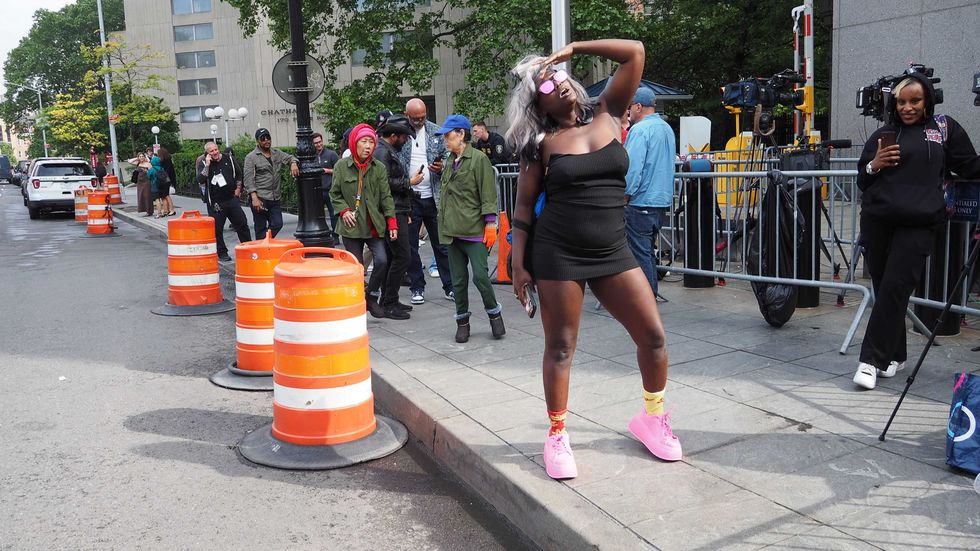
“Miss Combs, you so fine! I’d drink your bathwater!” a YouTuber shouts as Diddy’s mother climbs into her van. The voice belongs to Donatpov—the same YouTuber who went viral for provoking Cardi B so much outside her assault trial she threw a pen at him.
Outside the courthouse, a curvy young woman jumps up and down, squealing that she’d kissed Diddy’s son Justin (on the cheek). “I KISSED JUSTIN COMBS! OMG!” she screams, posting the clip to TikTok. Back inside, the mood is more subdued. The big headline of the afternoon? Diddy allegedly threw a plate of spaghetti at his assistant.
I step into the elevator with Gene Deal, Donatpov, and a woman I’d seen around since day one. Donatpov asks Gene a question—and before I can blink, Gene has Donatpov by the collar. He hurls him across the hallway. Security stares at me like I’m supposed to intervene.
As Donatpov and Gene go at it, the elevator woman rematerializes to scream, simply, “I’m Asian!” (She isn’t.)
She pivots to Donatpov, who seems worse for wear.
“Why are you not telling the truth? My name is Candor. I’m transparent. C-A-N-D-O-R!” she yells before storming off.
Donatpov tells her she looks like a pelican.
Getting checked by “Candor,” more popularly known as “Candy,” eventually becomes a rite of passage at the trial. She patrols Worth Street like it’s her personal MTA platform, policing anyone who dares mess with Deal or any of her line-sitter allies.
Candy will become known internationally when she’s dragged out of Room 26B by US Marshals for screaming in the middle of testimony about a gun—loudly enough to make Diddy himself whip his head around in shock. Mouth open, stunned, as if even he couldn’t believe the circus had breached containment and rushed inside.
The fights outside the courthouse intensify the closer we get to verdict day. The Hollywood Creeper starts rollerblading to court like he’s in an ‘80s coming-of-age film. He glides through the federal grounds with random props, a dusty computer modem in one hand, a single ski in the other. For closing statements, I have no choice but to use him as my line-sitter, despite the “professional” line-sitters’ warnings that he’s banned. I end up pushing through the doors anyway.
We’re closing in on verdict day when Diddy, in a mustard-yellow shirt, walks into the courtroom clutching a new book. As he turns around, I ask him to hold it up—The Magic of Believing—a self-help manual about using the subconscious mind to manifest your desired reality.
“Diddy’s manifesting an innocent verdict,” I tell my audience, an exclusive that’s soon picked up by multiple outlets.
Those mainstream TV stations like NewsNation and ABC start booking more of us—the YouTubers, Substackers, and livestreamers—as nightly guests to add “courtroom perspective” to their nightly segments. By the final week, I’m on Ashley Banfield’s show predicting that the jury won’t hit Diddy with the RICO. I’ve been watching jurors laugh at parts of the prosecution’s closing arguments, nodding along with defense attorney Mark Agnifilo when he quips, “Wow, feds, you really did it this time—you got the baby oil off the streets!”
The courtroom gasps when the verdict drops: Diddy will walk free on the biggest charges.
Outside, chaos erupts. A swarm of YouTubers and influencers tear off their shirts and douse each other in baby oil to celebrate.
“MORE OIL! MORE OIL!” Armon Wiggins shouts, shirtlessly gleaming under the courthouse lights as he smears more Johnson & Johnson’s across his abs—just the way Diddy likes it.
The moment goes nuclear on TikTok and Twitter. Even the Citizen community crimewatch app sends a push alert: Crowd Spraying Baby Oil Outside Courthouse After Verdict Reached in Sean “Diddy” Combs Trial.
Diddy’s defense attorney Mark Agnifilojokes that the feds got the baby oil off the streets. Just twenty-four hours later, it’s back.
Meanwhile, Charlucci is handing out custom Luccibrand NYC T-shirts reading “A Freako Is Not a Rico.” I grab a neon green one and film a TikTok. An hour later, my face is splashed across the Daily Mail, cemented next to Diddy on the cover of the New York Post. Overnight, I become the face of the Freako Is Not a Rico movement—frizzy, heat-fried hair and all, looking like I’d just stepped off the set of 8 Mile.
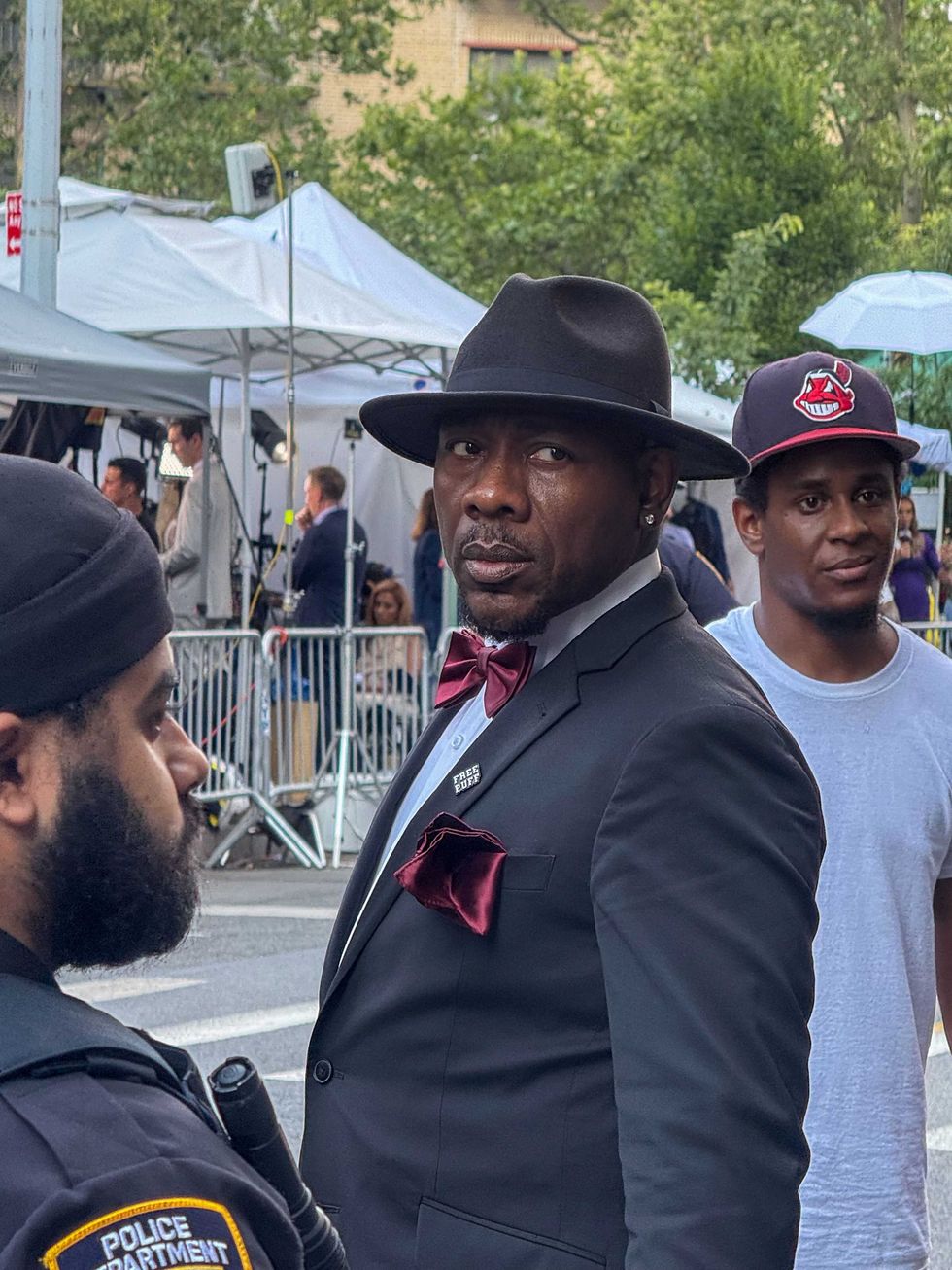
Suddenly, we realize, the news has reframed us—no longer sources but circus freaks. “They were just waiting for us to slipup,” one independent reporter sighs over lunch, doom-scrolling through the headlines.
The internet dutifully roasts us. “Social media got people’s brains FRIED,” one commenter posts. “And THESE are the people y’all trust as journalists?” another sneers.
But here’s the truth: we were right from the beginning. From day one, most of the independent media said that Diddy would walk on the RICO while the legacy press had the entire country convinced he’d be behind bars for decades.
“Today was a big win for Diddy. But it’s also a big win for independent media,” I tell my audience, high-fiving the other internet reporters who also nailed the verdict as they run out of the building to share the news.
That night, Dana Tran, the mother of Diddy’s youngest daughter, Love Sean Combs, leaves a comment on my Instagram post:
Witnessing all of you journalists build a community and all these new friendships was probably the most beautiful part of this all. It made my day seeing everyone so happy to reunite with each other each day.
I had no idea she was even watching.
Back in my Los Angeles apartment, I’m counting down the days until I can return to my favorite place in America: that grimy Worth Street sidewalk.
In October, the media circus will return to Manhattan for Diddy’s official sentencing. I wonder how much time he’ll get. But honestly? I’m even more invested in the question of whether the Hollywood Creeper really filed that $100 million lawsuit against Secret Service Sam. If he did, that’s a trial worth covering.
Candy messaged me recently, asking if I’m covering the Luigi trial. She’s pivoted to TikTok now, racking up followers with her brutally honest livestream recaps. She says she’s still banned from 500 Pearl Street but swears she’ll be outside, manning the sidewalk like always.
The buzz for this one is already insane. Luigi has fangirls lining up with pink posters like it’s Taylor Swift’s Eras Tour.
That trial is expected to be huge, but nothing will ever top the chaos of Diddy. Some people reminisce about college as the best days of their lives. Lately, I’ve been saying the Diddy trial was among the best times of my life.
The mainstream media made it out to be a crucible where only the strong could survive. But I didn’t just live to see the end. I stepped into the center ring.
I’d always wanted to run away and join the circus. For two months, I did.
Emilie Hagen is a pop culture writer based in Los Angeles. You can find her on Instagram and Substack.
Emilie Hagen